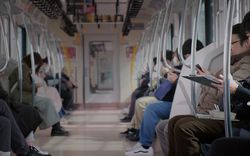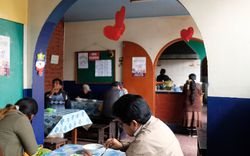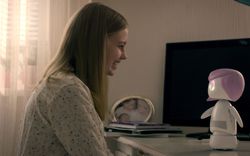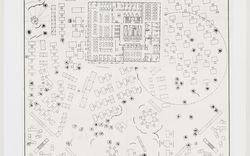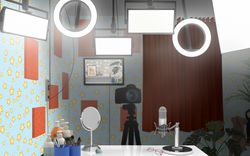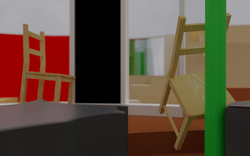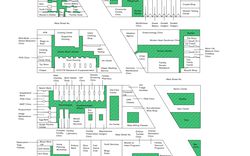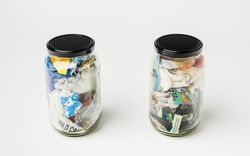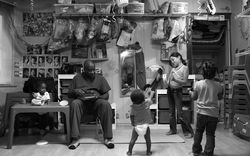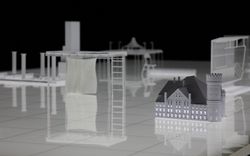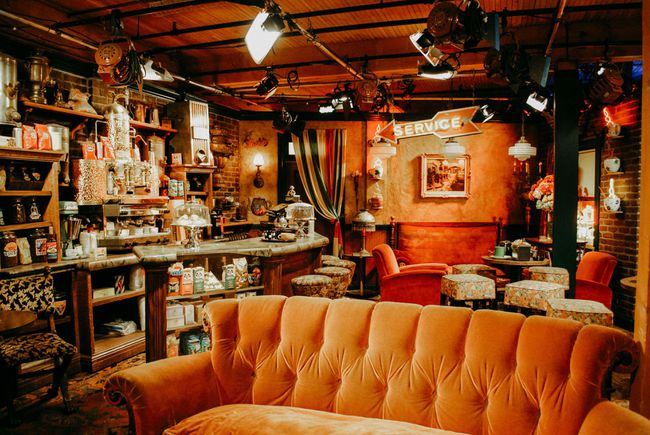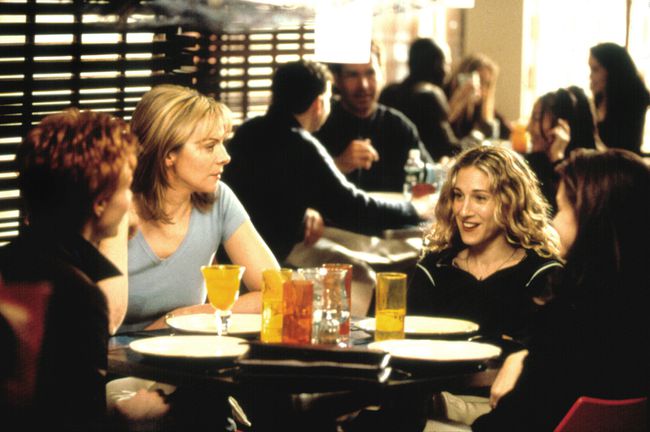Sit-coms, dramas, dramedies and other stories about society
Andrea Bellavita interviewed by Francesco Garutti on the evolving culture of television series, between anticipating societal transformations and documenting the now
- FG
- Your research for A Section of Now attempts to track the evolution of the most significant social transformations of our time by using TV series as a revelatory tool. The stories, plots, characters, objects and spaces of this specific entertainment format can be seen as indicators of what we are today. But just what is a TV series, and when did you begin conducting research on this theme?
- AB
- The fundamental characteristic of a TV series is precisely its serial organization. The main difference with respect to film or other audiovisual narrative forms that are self-standing or self-contained, is that the series calls for episodes, minimum units that are produced and viewed one after another. Nevertheless, this is obviously not a specificity of television, in the sense that the basic structure of the serial is first of all literary in nature. From the novel of installments onward, there is this idea of construction in relation to the spectator, an ongoing relationship. And to talk about fictional series means talking about the television industry, therefore addressing the monetization of spaces and the presence and loyalty of the viewer. The logic is to truly take you from one episode to the next. So the big problem is: how do I keep the spectator’s attention, and how do I foster this ongoing engagement?
The major innovations begin at the end of the 1980s, in substance. The main change of the model shifts the format from the “vertical” series to the “horizontal” series. In the vertical series each episode is equal, on its own terms, while in the horizontal series there is a narrative that moves forward from episode to episode. The relationship with the viewer is completely different. From a series of episodes to a larger story. For those involved in world building, the perspective is incredibly new: the script is no longer limited to the two hours of a film, nor to the 40 minutes of an episode; it develops in a story that lasts 10-12 hours.
- AB
- I divide my research into three main phases. Everything begins with the compulsive viewer of American fiction in the 1980s, a vertical fiction entirely made of repeating episodes. Then, late 1980s, early 1990s, come the epiphanies of Miami Vice (NBC, 1984–1989) and Twin Peaks (ABC, 1990–1991). It is no coincidence that filmmakers like David Lynch or Michael Mann begin to appear on the scene. But obviously the big revolution coincides with the late 1990s, with the advent of cable TV in the United States ¬– HBO and Showtime, which start to produce seminal shows like Oz (1997–2003), Sex and the City (1998–2004), The Sopranos (1999–2007), and Six Feet Under (2001–2005), and then with the generation of basic cable, AMC and FX, that release Mad Men (2007–2015), Breaking Bad (2008–2013), The Walking Dead (2010–), Sons of Anarchy (2008–2014), American Horror Story (2011–), and Fargo (2014–).
With the advent of the productions of the streaming players—Netflix, Amazon, Apple, Disney, etc.—that coincided with the launch (and the success) in 2013 of House of Cards and Orange Is the New Black, the model changes once again. There is no palimpsest, no precise schedule. Everything is always available, to the point of generating a mode of consumption like “binge viewing”: watching for six, seven, eight hours in a row, or all night long. The stories have to stand up to this continuity and a product once considered inferior to cinema becomes more complex.
- FG
- How have these phases of television to which you refer influence the construction of formats?
- AB
- There are two specific series that can be studied as tools to understand certain transformations of models and formats. One of them is Hill Street Blues (NBC, 1981). This is the moment of birth of the serial—that is, a horizontal narrative that merges with the vertical one of the episode. But it was not only the construction of a text, of a different plot. The authors set out to generate a new pact with the viewer, getting beyond the individual repeating episode. The characters are problematic, the critical situations can also be stinging in their impact. Hill Street Blues is the story of a police precinct, hypothetically set in New York, where the police officers are not the positive personalities of the series in the 1970s; they have problems with their families, their relationships, they struggle with drug use and the effects of drinking. Everything that existed previously is thrown into crisis, in terms of format and plot. Towards the end of the 1980s the series, the TV fiction, stops being completely reassuring; it is no longer just a euphoric mirror of the society, but begins to become its dark mirror.
The other very interesting case study, in this sense, is the latest Disney+ series, WandaVision. Wanda and Vision are two Marvel characters—coming from the narrative continuum of the Marvel Cinematic Universe—who live in an American sit-com small town. Every episode is contextualized in one historical period of the American family sit-com. Therefore the early installments are in black and white, replicating the fiction programs of the 1950s such as I Love Lucy, and the chronology gradually moves forward to the classic imaginary of the 1980s (Family Ties, Growing Pains, Roseanne) and to the new models of representation of the family, such as Malcolm in the Middle (Fox, 2000–2006) and Modern Family (ABC, 2009–2020). - FG
- A meta-series.
- AB
- Exactly. And the very interesting thing is that the relationship between Wanda and Vision goes into crisis during the course of the episodes, and the passage from the idyllic couple to a difficult relationship literally reflects the way the sit-com has represented the transformation of the couple and the family over the years. Fiction – as we were saying – starts to come to terms with crisis.
- FG
- Exactly why has this shift taken place from the representation of a dream, an idyllic world, to the narration of crisis on television? Obviously in those years the world was going through critical, political and social reflections after the movements of 1968; but what were the mechanisms of television that drove and permitted this transformation?
- AB
- In the United States—the central location of production and innovation in television—on the one hand we were entering the phase of Reaganite hedonism, but on the other hand the country must still process the tragic experience of Vietnam, the assassination of JFK and of figures such as Martin Luther King and Malcolm X, social dramas that intersect with mass culture. But once again, the key moment comes in the late 1990s with the passage from broadcasting to narrowcasting. The system of pay television channels grew, cutting out segments of the audience, in a selection of a socio-economic and in certain cases socio-cultural order. With the “pay” channels it is no longer necessary to reach everyone, no longer necessary to insert advertising inside the product, and investors are kept outside of the content. It is possible to show a maximum security prison and violence in Oz; you can tell the story of a mafia family like The Sopranos, because a brand like Unilever, for example, can no longer insert its ads in commercial breaks in the middle of each episode. This scenario – as had already happened for the new Hollywood in movie theaters – opened up a new field of cultural creativity. Authors appeared, as well as showrunners, i.e. people who focus on the writing of fiction, in exactly the same way one might focus on literature.
- FG
- Are smartphone series the latest phase of this evolution?
- AB
- Yes, but they didn’t work. Quibi, for example—an investment project involving prominent figures in the media system such as Jeffrey Katzenberg, who co-founded DreamWorks with Steven Spielberg—shut down a short while ago. The idea was to generate short content, released every week, like bites to watch on a mobile phone (Quibi derives from Quick Bites), after which the user could enjoy a small assembled film. Snapchat and YouTube are also backtracking in this sense. The global market trend points to big mergers. Reinforcement rather than fragmentation.
- FG
- How can TV series help us to track social change?
- AB
- Fictional series do not foreshadow developments, but work on a principle of recognition. They discover what already exists and then apply a “circumstantial” logic, managing to intercept particularly pertinent issues – that perhaps were still under our radar – then putting them on stage. Obviously, however, the link between reality and representation is now much quicker. Today we can make series that reflect phenomena that are still red-hot topics. An intuition can suffice to immediately activate a scriptwriting machine to construct the product. Then it is divided up, in the sense that selected contents are then aimed at a specific audience niche, so the theme under discussion becomes even more pertinent. In the 1980s the family you saw on a big screen was not the family “of your present” – while today even the most generalist series, in the representation of the family and the social dynamics connected to it, are absolutely up to date and timely.
In this sense, the true magical object of contemporary fiction really is Black Mirror (Channel 4 and Netflix, 2011–2019), i.e. its creator, Charlie Brooker. Through the lenses of technological dystopia, Brooker narrates a present that mingles with and incorporates the near future, foreshadowing trends, producing a true mental short circuit.
- FG
- Which series have gathered the clues of the present to narrate social transformations on the theme of the family?
- AB
- The family is the content par excellence developed in three narrative dimensions: the sit-com, the dramedy and the drama. The sit-com is the canonic site of representation of the family, as can be seen in the case of WandaVision, and for years it has been the context whose real-representation ratio has always lagged further “behind.” The turning point here is undoubtedly Friends, which started airing in the mid-1990s (NBC, 1994–2006). This was the first show to formally acknowledge the principle that family is not a matter of blood relations: the family is the group. In this sense, the other outstanding example is the more recent Modern Family (ABC, 2009–2020). The latter is an absolutely innocuous series, without a critical stance, totally stereotyped, yet it is also the series in which the extended family is definitively “normalized.” Friends and Modern Family have literally created an imaginary. When it comes to dramedy, another apparently banal but mass-audience program is Gilmore Girls (The CW, 2006–2016). The theme is the breakdown of the generation gap: a home, a family of women only, without father figures, where a generational identity is shared by mother and daughter in a sort of advanced sorority relationship. In the case of drama, the example is undoubtedly The L Word (Showtime, 2004–2009)—because it represented the first series on the female homosexual universe—which then leads to The New Normal (NBC, 2012). I find an author like Ryan Murphy particularly absorbing, and I think the first season of American Horror Story (FX, 2011) is actually a family story. The haunted house is the maximum place of crisis, the dissolution of the family.
- FG
- Which television programs have generated an imaginary in relation to the world of work?
- AB
- Ally McBeal_ (Fox, 1997–2003) manages to completely hold together the representation of work, in an almost philological manner, with other levels of portrayal, such as comedy and even the musical. Another example is clearly The Office, either in its British version (BBC Two, 2001–2003) or in the American one (NBC, 2005–2013). And of course also Mad Men (AMC, 2007–2015), one of the texts on which the criticism and theory on the concept of nostalgia and its overcoming have been most widely developed. But it is important to emphasize that the representation of work space in The Office, once again, is a simulacrum, a bit like the sofa of Friends: these two locations, which seem like the most familiar things in the world, do not actually exist. We are talking about two places, spaces, objects that have shaped our idea of the office, our idea of the couch in a cohabited house. An imaginary that has truly replaced our perception of reality.
- FG
- The circumstantial principle and the ability to construct an imaginary operate in parallel. The landing that separates – or connects – the two apartments in Friends has become a kind of space of reference for many college students.
- AB
- Exactly. The serial fiction operates in proactive terms, i.e. creating imaginaries, through simplification. In critical terms, however, it works in a circumstantial way. The sofa of Friends, the workplace of The Office, but also the characters of La Casa de Papel (Antena3 and Netflix, 2017–), are obviously simplifications, offering a model of reduced complexity. Precisely because they represent a simple model, it is possible to aspire to repeat them. Another exemplary case in this sense is indubitably the teen drama. How has the relationship between adolescents developed? There is a line that runs from Beverly Hills 90210 (Fox, 1990–2000) to Dawson’s Creek (The WB, 1998–2003) and The OC (Fox, 2003–2007), all the way to Teen Wolf (MTV, 2011-2017). This is the construction of an imaginary and at the same time of a “simple” model of reality – non-complex and generally euphoric cognitive patterns – towards which we can reach, or which we can want to imitate. These are very interesting case studies. As I was saying, the area of comedy works by simplification, while that of drama exploits the circumstantial principle, revealing critical aspects. But it is important to explore both models of representation of reality, because the mistake that is often made is to focus only on drama. Instead, this is an interconnected system. If we want to use fiction to interpret the world, we cannot explore only “high” fiction.
- FG
- Which of the spaces formulated by TV series have become iconic, in your view, precisely because they have been able to foresee transformations, or simply to document reality? The school corridor of teen dramas is famous by now as the site of social spectacle, of envy, encounters, love stories, friendships, episodes of bullying.
- AB
- The corridor with lockers in teen dramas is an iconic image of exceptional power. When Lynch has to introduce for the first time the character of Audrey Horne, the perverse nymph, in Twin Peaks, he decides to show her as she removes her high-heeled shoes and puts out a cigarette in a corridor locker. Elephant (2003), the film by Gus Van Sant, narrates the tragedy of Columbine inside the school corridor. The corridor of the American school has so thoroughly permeated the non-American imagination that even without the lockers, we might say it has become an “other” place with respect to a mere zone of circulation from one classroom to another, for teenagers all over the world.
The transformation of everyday domestic space into “other” space is clearly visible and meaningful in the case of the sit-com. Because sit-coms are shot in what is technically defined as multi-camera format, exclusively with a fixed camera, and predominantly in a frontal view. Obviously this structure of the set has generated a theatrical, frontal idea of relations. The sofa of Friends institutionalized an idea of frontal face-off with the viewer, even in the case of a four-way conversation. The characters of the series are seated on the front of a stage, in spite of their attempt to simulate a domestic tableau. The camera defines a space that has no depth of field, which indicates the various settings but rarely their connections. It is as if it were a space of monads, autonomous spaces, without crossings. And the moment in which the camera narrates the spaces of relation is a crucial one. In all American homes, the teenager goes upstairs to his or her room to cry, and then at a certain point a parent enters the room. But it is only with Modern Family that the camera follows the character on the stairs. In contemporary fiction the camera “turns” the steps – we are getting closer the methods of cinema. Closer to a representation that, for us, is paradoxically more classical. - FG
- But why is it that the home in the American sit-com has never basically changed across the decades?
- AB
- The house of Shameless—in its original British version (Channel 4, 2004–2013) and also in its American one (Showtime, 2011–2021)—is a real house. The house of a sit-com is a totally anti-realistic house, totally crystallized for a long time. The family has changed, becoming multi-cultural, multi-generational, extended, widened to take in differences of gender, but the space of the home has remained the same for many years. Once again, WandaVision is useful to understand many things, also in this sense. In the passage from one season to the next the objects change, from the black and white television to the cathode ray tube to the plasma display, from Fifties armchairs to modern design, flowers, plastic. But the house is always there, identical. As if the authors were trying to tell us that for the sit-com the function of the house doesn’t change. It is always the reassuring setting of the roots of this narrative model. In this sense, the British TV series have been harder than the American shows, from the outset. The tradition is very different. The basis of the British models is that of soap operas like EastEnders (BBC, 1985–), relying on a script that narrates the life of the lower classes, the places, situations and problems of a typical neighborhood in East London. The American sit-com has never talked about the proletariat; it has always narrated the middle class, from the early years to the present.
This interview with television historian Andrea Bellavita was conducted as part of the Catching Up With Life project. Andrea Bellavita is TV consultant for the upcoming exhibition A Section of Now: Social Norms and Rituals as Sites for Architectural Intervention.

